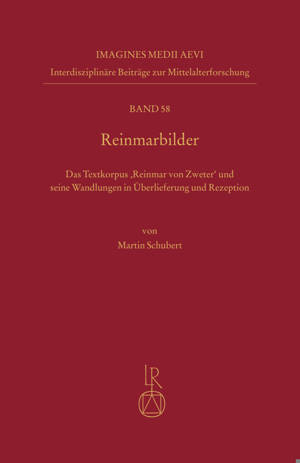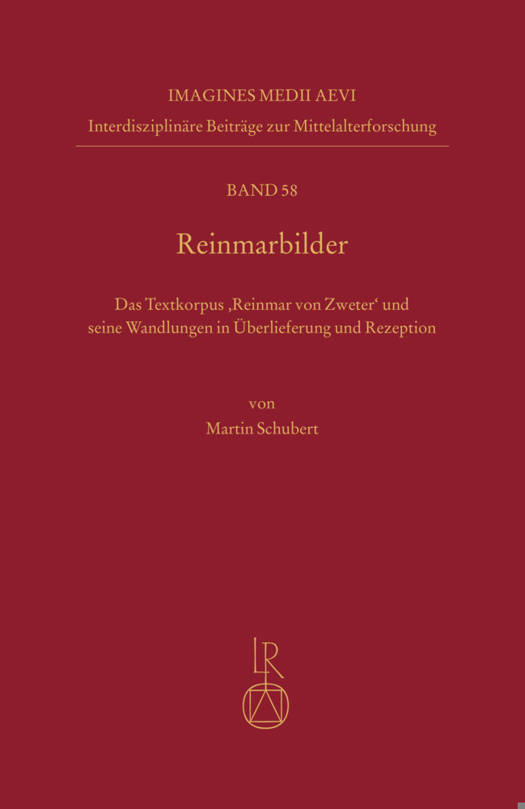
En raison d'une grêve chez bpost, votre commande pourrait être retardée. Vous avez besoin d’un livre rapidement ? Nos magasins vous accueillent à bras ouverts !
- Retrait gratuit dans votre magasin Club
- 7.000.000 titres dans notre catalogue
- Payer en toute sécurité
- Toujours un magasin près de chez vous
En raison de la grêve chez bpost, votre commande pourrait être retardée. Vous avez besoin d’un livre rapidement ? Nos magasins vous accueillent à bras ouverts !
- Retrait gratuit dans votre magasin Club
- 7.000.0000 titres dans notre catalogue
- Payer en toute sécurité
- Toujours un magasin près de chez vous
Reinmarbilder
Das Textkorpus 'Reinmar von Zweter' und seine Wandlungen in Überlieferung und Rezeption
Martin Schubert
Livre relié | Allemand | Imagines Medii Aevi. Interdisziplinäre Beiträge zur Mittelalterforschung | n° 58
144,45 €
+ 288 points
Description
English summary: Reinmar von Zweter is the most important Sangspruch poet between Walther von der Vogelweide and Frauenlob. The impressive corpus of poems attributed to him contains political, didactic, and spiritual stanzas as well as the religious 'Leich'. The reception of this corpus in the 13th century and long thereafter is quite extraordinary. Nevertheless, this oeuvre has not been the focus of a more detailed study since Gustav Roethe's comprehensive Reinmar edition (1887). For a long time, the oeuvre has been used for biographical interpretations only. Here, the aspect of the 'Reinmar images' emphasizes the various perspectives when looking at the poems. A detailed manuscript analysis shows how different images of 'Reinmar' were activated with each manuscript. The fact that the transmission can be traced back to an old Sangspruch collection, most likely from the author's lifetime, connects him in a special way with the manuscript culture of the 13th century. The Leich was intensively received, according to the number of manuscripts and the Latin contrafactum; the early fragments from the 13th century are unique within the genre. Reinmar images span from the written records and the picture in the Codex Manesse, over the fictional character 'Reinmar' in the 'Wartburg Contest' and references by other poets. For the notorious invective doenediep, it is argued that the ambiguity might be intentional. In the chain of images, Roethe's edition is considered another construct. The literary study of the core corpus is divided in thematic cross sections. Special attention is paid to the catechetic aspects of the religious stanzas, the educational background, the role of the speaker, witticisms, and religious subtexts. In this case, the concept of the 'author' is not the aim of a biographical construct, but rather an index function of the texts which points to a moment in the history of literature. Thereby, new perspectives are opened on the innovations of an oeuvre that should not be considered epigonal again. German description: Reinmar von Zweter, der wohl wichtigste Sangspruchdichter zwischen Walther von der Vogelweide und Frauenlob, hat mit seinen politischen, didaktischen und geistlichen Strophen sowie mit seinem religiosen Leich ein beeindruckendes Korpus hinterlassen, dessen Rezeption im 13. Jahrhundert und lange daruber hinaus ganz aussergewohnlich ist. Dennoch stand dieses Oeuvre seit der umfassenden Reinmar-Edition Gustav Roethes (1887) nicht mehr im Zentrum einer ausfuhrlicheren Untersuchung; lange Zeit wurde das Werk vor allem fur biographistische Interpretationen herangezogen. Der Aspekt der 'Reinmarbilder' betont demgegenuber die Vielfalt der Perspektiven, die sich beim Blick auf das Werk ergeben. Die detaillierte Handschriftenanalyse zeigt, wie bereits im Mittelalter bei jeder Niederschrift und jeder Sammlung ein anderes Bild von Reinmar aktiviert wird. Dass die Uberlieferung auf eine wohl bereits zu Lebzeiten des Autors entstandene Sangspruch-Sammlung zuruckzufuhren ist, die hier neu eingegrenzt werden kann, weist auf einen besonderen Bezug zur Schriftlichkeit und ist im 13. Jahrhunderts einmalig. Der Leich wurde intensiv rezipiert, wie die Uberlieferung und die lateinische Kontrafaktur belegen; auch hier sind die fruhen Fragmente im 13. Jahrhundert in der Gattung einzigartig. Die Kette der Bilder erstreckt sich von der Schriftuberlieferung uber die Dichterminiatur der Grossen Heidelberger Liederhandschrift, uber die literarische Figur 'Reinmar' im 'Wartburgkrieg' und die Nennungen bei anderen Autoren sowie in Dichterkatalogen. Beim notorischen doenediep-Vorwurf wird keine Vereindeutigung des Begriffs angestrebt, sondern vermutet, dass die Mehrdeutigkeit intentionaler Bestandteil der Invektive ist. In dieser Kette von Bildern wird die Pragung in Roethes Edition als ein weiteres, diesmal wissenschaftliches, Konstrukt erwiesen. Die literaturwissenschaftliche Untersuchung des Kernkorpus verfahrt in verschiedenen thematischen Schnitten; hier wird vor allem auf die katechetischen Aspekte der geistlichen Strophen, auf die verarbeiteten Bildungsinhalte, die Sprechhaltungen, auf Sprachspiele und religiose Subtexte geachtet. Der einheitsstiftende Begriff des Autors ist in diesem Fall nicht Ziel eines biographischen Konstrukts, sondern eine Indexfunktion der Texte, die auf einen literaturhistorischen Zeitpunkt verweist. Damit werden neue Blicke auf das innovative Potential des Oeuvres geoffnet, womit es aus dem Schlagschatten bekannterer Zeitgenossen heraustreten durfte.
Spécifications
Parties prenantes
- Auteur(s) :
- Editeur:
Contenu
- Nombre de pages :
- 660
- Langue:
- Allemand
- Collection :
- Tome:
- n° 58
Caractéristiques
- EAN:
- 9783752007787
- Date de parution :
- 03-06-24
- Format:
- Livre relié
- Format numérique:
- Genaaid
- Dimensions :
- 180 mm x 43 mm
- Poids :
- 1233 g

Les avis
Nous publions uniquement les avis qui respectent les conditions requises. Consultez nos conditions pour les avis.






